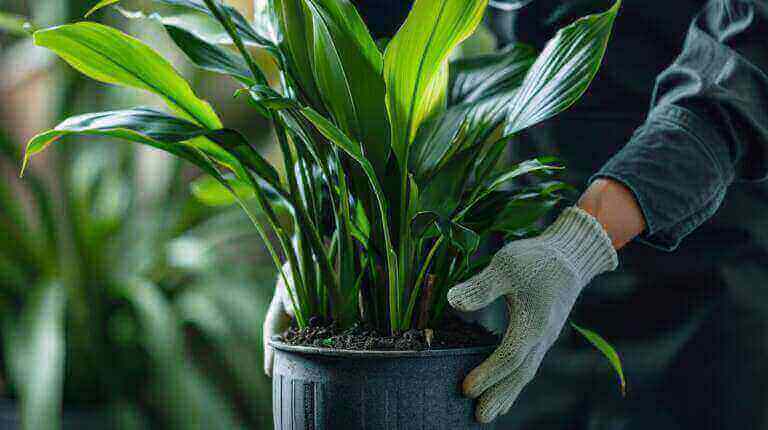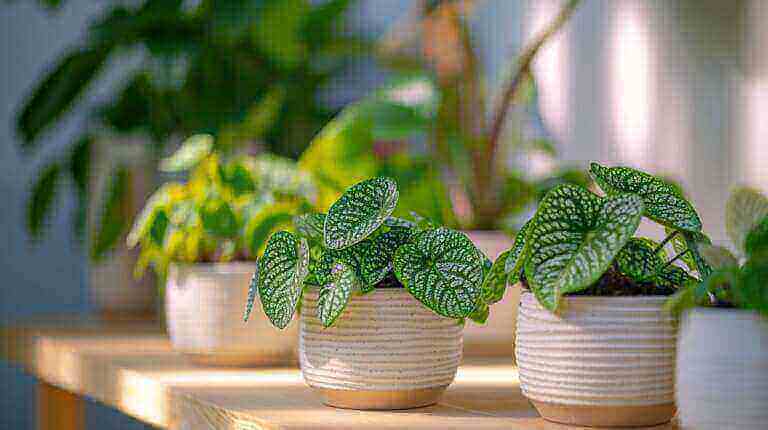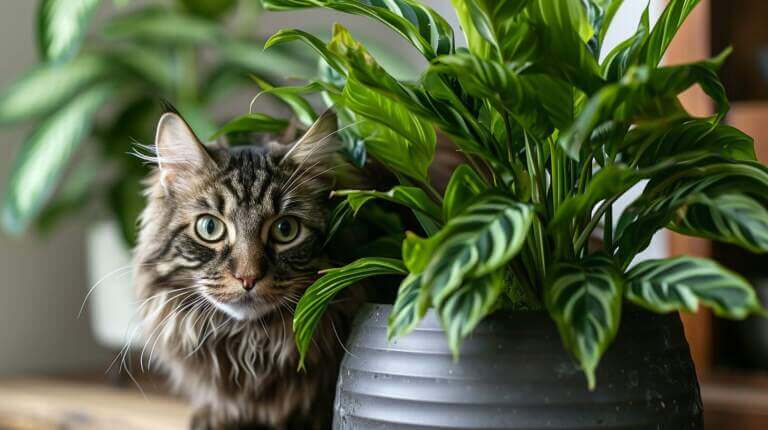If you’ve noticed your snake plant’s leaves drooping, you’re likely worried about its health. Although one of the most common indoor houseplants, snake plants can develop issues like any other plant. The good news is that drooping leaves are often easy to fix if you catch the problem early.
In this article, we’ll cover the reasons your sansevieria may be drooping and how to revive it. You can get your snake plant back to perfect health with simple fixes like adjusting its watering, providing more sunlight, or repotting. We’ll also go over what causes drooping in the first place and how to prevent it in the future.
While droopy leaves of sansevieria can be alarming, it’s usually an easy issue to diagnose and address. Your snake plant will return to its upright and lush appearance with proper care. Learn why your snake plant is drooping and how to perk it back up!
Key Takeaways
- Drooping snake plants can be a sign of underlying issues such as overwatering or lighting problems.
- Overwatering can lead to root rot and weakened plants, while inadequate lighting can hinder photosynthesis and weaken the plant.
- To address overwatering, use well-draining soil and allow the soil to dry out between waterings.
- To address lighting problems, move the plant to a location with brighter, indirect light or use supplemental artificial lighting.
Signs of a Drooping Snake Plant
One of the most notable signs of a drooping sansevieria is the significant decrease in upright leaves. When a snake plant begins to droop, it often indicates underlying issues like overwatering or insufficient light.
Overwatering is a common reason your snake plant is drooping, as these plants are native to arid regions and don’t need frequent watering. Consistently wet soil can cause root rot, weakening plants and drooping leaves. To fix a drooping snake plant from overwatering, repot the plant in well-draining soil and water only when the top inch is dry.
Insufficient light can also cause a snake plant’s leaves to droop as it struggles to photosynthesize. Although snake plants can tolerate low light, they thrive in bright, indirect sunlight. If the light is limited, move the plant to a brighter spot or use supplemental lighting. With the proper adjustments to watering and light, you can revive a drooping sansevieria and get your snake plant’s leaves standing upright again.
Common Causes of a Drooping Snake Plant
Overwatering and insufficient light are common causes of drooping sansevieria. Excessive watering can lead to root rot, while inadequate sunlight hinders photosynthesis – both issues can make snake plant leaves droop.
Overwatering is a particularly common reason why your snake plant may be drooping. When the soil stays wet, oxygen can’t reach the roots, causing them to rot and weaken. To prevent overwatering, allow the soil to dry out between waterings and repot the plant if needed. Water your snake plant only when the top inch is dry.
Similarly, insufficient light can cause the leaves to droop as the plant struggles to photosynthesize. Snake plants need at least 6 hours of bright, indirect sun daily. If the light is limited, move the plant or use supplemental lighting. With adjustments to watering and light, you can fix a drooping snake plant and stop the leaves from drooping further.
Reviving a Drooping Snake Plant: Step-by-Step Guide
To effectively revive a drooping snake plant, following a step-by-step guide that addresses the specific care needs and provides actionable solutions is crucial. Here is a comprehensive guide on reviving a drooping snake plant and ensuring its overall health and vitality.
First, it is important to understand the common causes of a drooping snake plant, such as overwatering, underwatering, improper lighting, or pests. Once you have identified the cause, you can take appropriate measures to revive your plant.
How to Revive a Drooping Snake Plant: Step-by-Step Guide
| Steps | Actions |
|---|---|
| 1 | Check the soil moisture and adjust watering accordingly. |
| 2 | Ensure proper drainage to prevent waterlogging. |
| 3 | Provide adequate sunlight or artificial light. |
| 4 | Treat any pests or diseases that may be affecting the plant. |
| 5 | Trim any damaged or dead leaves to encourage new growth. |
Following these steps can revive your drooping snake plant and promote its overall well-being. However, to maintain a healthy sansevieria, it is important to implement essential care tips, which will be discussed in the subsequent section.
Transitioning into the next section, let’s explore the essential care tips for a healthy Sansevieria.
Essential Care Tips for a Healthy Sansevieria
In order to ensure the health and vitality of your sansevieria, it is essential to follow these care tips diligently:
- Watering Frequency: Sansevieria is a drought-tolerant plant, so it is important not to overwater it. Allow the soil to dry out completely between waterings, and then water thoroughly, ensuring that excess water drains away.
- Sunlight Requirements: Sansevieria thrives in bright, indirect light. Place it near a window where it can receive bright, filtered sunlight for a few hours a day. Avoid exposing it to direct sunlight, as it can scorch the leaves.
- Well-draining Soil: Use a well-draining potting mix specifically formulated for succulents or cacti. This will prevent water from sitting around the roots, preventing rot.
- Temperature and Humidity: Sansevieria prefers temperatures between 60-85°F (15-29°C) and moderate humidity levels. Avoid placing it near drafty windows or air conditioning vents, as it prefers stable conditions.
- Fertilization: Feed your sansevieria with a balanced, diluted houseplant fertilizer once every 2-3 months during the growing season (spring and summer). Be cautious not to over-fertilize, as it can lead to leaf burn.
Preventing Drooping in Your Snake Plant: Long-Term Care Strategies
Although drooping is a common issue with snake plants, implementing long-term care strategies can effectively prevent this problem and ensure the plant’s healthy growth. Snake plants, known as Sansevieria, are popular houseplants due to their low maintenance and air purifying properties. However, if not properly cared for, they can experience drooping leaves, often a sign of underlying issues.
It is important to take preventive measures and apply proper maintenance techniques to prevent drooping in your snake plant. Firstly, ensure that you are providing the right amount of water for your plant. Overwatering can lead to root rot, causing their leaves to droop. Let the soil dry out between waterings and avoid leaving your snake plant sitting in standing water.
In addition, providing adequate sunlight is crucial for the health of your snake plant. These plants thrive in bright, indirect light, so placing them near a window or providing artificial grow lights can prevent drooping caused by insufficient light.
Furthermore, regular fertilization and repotting can help maintain the proper nutrient balance and prevent overcrowding of roots, which can also lead to drooping. Use a well-balanced fertilizer and repot your snake plant every 2-3 years to ensure optimum growth.
Frequently Asked Questions(FAQ) Fix Drooping Snake Plant
What Are Some Tips for Reviving a Drooping Snake Plant?
To revive a drooping snake plant, there are proven techniques for thriving sansevieria growth. Firstly, ensure the plant receives adequate sunlight but avoid direct exposure to harsh rays. Secondly, water the plant moderately, allowing the soil to dry between watering sessions. Lastly, repot the snake plant if the roots are overly crowded. These tips can help rejuvenate your drooping snake plant.
What Are Some Tips for Reviving a Drooping Snake Plant?
To revive a drooping snake plant, there are proven techniques for thriving sansevieria growth. Firstly, ensure the plant receives adequate sunlight but avoid direct exposure to harsh rays. Secondly, water the plant moderately, allowing the soil to dry between watering sessions. Lastly, repot the snake plant if the roots are overly crowded. These tips can help rejuvenate your drooping snake plant.
Are Yellowing and Drooping Snake Plant Related?
If you notice your snake plant turning yellow, it may be a sign of drooping leaves. However, yellowing and drooping are not always directly related in snake plants. Both issues can be caused by overwatering or underwatering, as well as poor lighting conditions. Identifying the underlying cause is crucial for nursing your snake plant back to health.
Can Overwatering Cause a Snake Plant to Droop?
Overwatering can cause a snake plant to droop. The effects of overwatering include root rot and a lack of oxygen to the roots, leading to wilting and drooping leaves. Signs of overwatering include yellowing leaves and a soggy soil texture.
Can Direct Sunlight Cause a Snake Plant to Droop?
Direct sunlight can cause a snake plant to droop if it is overexposed. Snake plants thrive in bright, indirect light, and signs of overexposure include yellowing or browning leaves. Proper placement is crucial for their well-being.
What Should I Do if My Snake Plant Is Drooping but the Soil Is Dry?
If your snake plant is drooping, but the soil is dry, it may indicate underwatering. Ensure you are using proper watering techniques, allowing the soil to dry out between waterings. Check for signs of root rot and adjust care accordingly.
Can a Snake Plant Recover From Severe Drooping Leaves?
Snake plants can recover from severe drooping if proper care is given. To revive a drooping sansevieria, ensure adequate sunlight, appropriate watering, and regular fertilization. Propagation can also be done to rejuvenate the plant. Watch out for common pests like spider mites and mealybugs.
Can Using Fertilizer Too Frequently Cause a Snake Plant to Droop?
Using fertilizer too frequently can lead to a snake plant drooping. Proper snake plant care involves using a balanced fertilizer and following the recommended dosage. Over-fertilization can cause root damage and result in drooping leaves.
Why is my snake plant drooping?
Snake plants droop for various reasons, including overwatering, underwatering, insufficient sunlight, or root problems. Identifying the cause to properly care for your droopy snake plant is important.
How can I revive a drooping snake plant?
To revive a drooping snake plant, assess the possible causes, such as watering issues or lack of sunlight. Adjust the watering schedule and ensure adequate light conditions. Consider repotting the plant with fresh soil if the root system is damaged.
How do I care for drooping snake plant leaves?
To care for a drooping sansevieria, ensure it is placed in a well-lit area but not under direct sunlight. Water the plant sparingly, allowing the soil to dry out between waterings. Avoid overwatering or keeping the plant in overly damp conditions.
What are common reasons for snake plant leaves to droop?
Common reasons snake plant leaves droop include overwatering, underwatering, insufficient light, root problems, or pests. Identifying the specific cause will help in properly addressing the issue.
How can I fix my drooping snake plant?
First, to fix a drooping snake plant, assess the cause of the drooping leaves. Adjust the watering schedule, provide adequate light, and check the root system for any issues. If necessary, repot the plant with fresh soil.
Do I need to repot my snake plant if it’s drooping?
Repotting your snake plant may be necessary if it’s drooping due to root problems or the current pot is too small. Transferring it to a larger pot with fresh, well-draining soil can help rejuvenate the plant.
What causes snake plant leaves to droop?
Snake plant leaves may droop due to overwatering, underwatering, lack of light, root problems, cold temperatures, or pests. Each plant’s situation may vary, so proper assessment is important to determine the cause.
What should I do if my snake plant’s leaves are drooping?
Check the watering schedule, lighting conditions, and the root system if your snake plant’s leaves are drooping. Adjust these factors accordingly to help the plant recover and prevent further drooping.
Are droopy snake plant leaves a sign of a problem?
Yes, droopy snake plant leaves can be a sign of an underlying problem. It’s crucial to investigate the cause and address it promptly to prevent further damage to the plant.
Why is my snake plant drooping?
Snake plants are resilient and can tolerate a range of conditions. However, drooping leaves may indicate the plant isn’t receiving adequate care, such as improper watering or lighting. Taking appropriate action can help restore the plant’s health.







